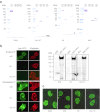Urinary podocalyxin is an early marker for podocyte injury in patients with diabetes: establishment of a highly sensitive ELISA to detect urinary podocalyxin
- PMID: 22854890
- PMCID: PMC3464371
- DOI: 10.1007/s00125-012-2661-7
Urinary podocalyxin is an early marker for podocyte injury in patients with diabetes: establishment of a highly sensitive ELISA to detect urinary podocalyxin
Abstract
Aims/objective: Nephropathy, a major complication of diabetes, is the leading cause of end-stage renal disease. Recent studies have demonstrated that podocyte injury is involved in the onset of and progression to renal insufficiency. Here, we describe a novel, highly sensitive ELISA for detecting urinary podocalyxin, a glycoconjugate on the podocyte apical surface that indicates podocyte injury, particularly in the early phase of diabetic nephropathy.
Methods: Urine samples from patients with glomerular diseases (n = 142) and type 2 diabetes (n = 71) were used to quantify urinary podocalyxin by ELISA. Urine samples were obtained from 69 healthy controls for whom laboratory data were within normal values. Podocalyxin was detected in urine by immunofluorescence, immunoelectron microscopy and western blotting.
Results: Morphologically, urinary podocalyxin was present as a vesicular structure; western blotting showed it as a positive band at 165-170 kDa. Levels of urinary podocalyxin were elevated in patients with various glomerular diseases and patients with diabetes. In patients with diabetes, urinary podocalyxin was higher than the cut-off value in 53.8% patients at the normoalbuminuric stage, 64.7% at the microalbuminuric stage and 66.7% at the macroalbuminuric stage. Positive correlations were observed between urinary podocalyxin levels and HbA(1c), urinary β(2) microglobulin, α(1) microglobulin and urinary N-acetyl-β-D-glucosaminidase, although urinary podocalyxin levels were not correlated with other laboratory markers such as blood pressure, lipid level, serum creatinine, estimated GFR or proteinuria.
Conclusions/interpretation: Urinary podocalyxin may be a useful biomarker for detecting early podocyte injury in patients with diabetes.
Figures



References
-
- Wright J. Review: the problem of diabetic nephropathy and practical prevention of its progression. Br J Diabetes Vasc Dis. 2008;8:272–277. doi: 10.1177/1474651408099654. - DOI
MeSH terms
Substances
LinkOut - more resources
Full Text Sources
Other Literature Sources
Medical
Research Materials
Miscellaneous

